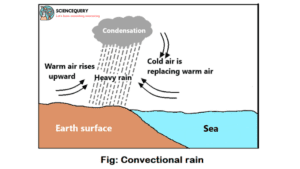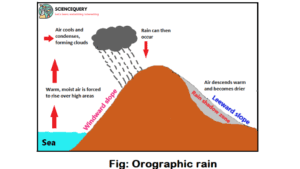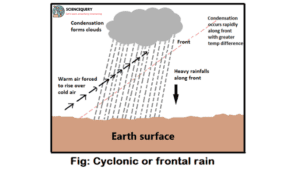
Introduction
Weather is consist of air temperature, pressure, humidity, precipitation, and wind conditions of a region. Rainfall is a very important component of weather. There are three types of rainfall. These are convectional rainfall, orographic rainfall or relief rainfall, and cyclonic or frontal rainfall. Below is a discussion of the different types of rainfall.
Rainfall is a condition of the weather of a region that depends on various elements. Water vapor cools and condenses in the upper sky to form clouds. These clouds contain numerous water particles and ice particles. These tiny water and ice particles combine to form larger water particles. Normally when a cloud floats in the sky, it condenses and falls to the earth’s surface under the force of gravity in the form of droplets, it is called rainfall (1) & (4).
Importance
1. Rainfall is a very important component of weather.
2. It is the key element in the earth’s water cycle.
3. These play a vital role in all life on earth.
4. This is the main way water from the sky descends to the earth, where it fills lakes and rivers, recharges underground aquifers, and provides drinking water for plants and animals.
5. Rainfall is the main source of energy that drives atmospheric circulation.
6. It plays an important role in crop production in agriculture.
7. Without rain, the soil can dry out and plants can die. When rain is below normal for weeks, months, or years, stream and river flow decrease, water levels in lakes and reservoirs drop, and water depths in wells increase.
8. Groundwater is recharged by rainfall hence its importance is immense.
9. Plants, animals, human life, etc. are immobile without rain.
10. Rainfall brings fresh water to the earth’s surface.
Types
There are three types of rainfall. These are
- Convection rainfall
- Orographic or relief rainfall
- Frontal rainfall.
Convectional rainfall

As the surface air warms, it becomes saturated with water vapor and becomes lighter, and rises by the convectional process. At this time, the water vapor coming into contact with the cold air first turns into clouds and then rain and descends straight down. This rainfall is called convection rainfall (2).
Features
- In the equatorial region, this type of rain occurs almost throughout the year in the evening and afternoon.
- This type of rain occurs when excess water vapor condenses as air heat is lost through the convection process.
- Convectional rain is higher in equatorial low-pressure areas because the ascending air in these areas contains a lot of water vapor.
- In the temperate zone, convectional rain occurs at the beginning of summer.
- Convectional rainfall with occasional localized thunderstorms and occasional hail.
- Generating convectional rainfall usually requires a lot of rainfall and intense solar radiation. So it can be said that convectional rain is a type of warm atmospheric activity.
- Also called 4 O’clock rain in the equatorial region.
- Convectional rain usually occurs from cumulonimbus clouds (1).
Stage
- The earth’s surface heats up rapidly due to the intense heat of the sun.
- Warm and light air above the earth’s surface rises and creates convection.
- As the rising air cools, condensation occurs in the presence of sufficient water vapor in the air.
- Condensation causes the clouds to spread far upwards to form cumulonimbus clouds. Such clouds produce convectional rain with storms and sometimes hail and thunder (3).
Orographic rainfall

Moist air full of water vapor is blocked by a high mountain and rises over the ridge. The rain that condenses on the leeward slopes of mountains when it comes in contact with the cold air above is called orographic rain. Mountains play an important role in generating this type of rainfall.
Features
1. Orographic rain occurs due to obstruction in the mountains.
2. It occurs from cumulus clouds.
3. High mountains obstruct warm and humid air.
4. It is also known as relief rainfall.
5. This type of rainfall occurs on the windward slope of the mountain.
6. One of the main features of orographic rain is the contrast of rain.
7. In orographic rain, when water vapor is trapped in a mountain and rises above a mountain, then this air mass condenses before it reaches the top of the mountain, causing heavy rainfall.
8. Orographic rain does not occur on the lee side of the mountain.
9. It occurs in any season.
10. This rainfall lasts up to a certain height and then decreases gradually.
11. Orographic clouds can produce both rain and thunderstorms (2) & (4).
Rainshadow zone
As the water vapor air flows over the surface, it is blocked by the mountain and rises up the mountain, and expands and cools. As a result, water vapor condenses and causes heavy rainfall on the lee side of the mountain.
When the air crosses the mountain and reaches the windward slope, the water vapor in the air decreases. In addition, the air passing over the mountain is armed as it descends down the mountain slopes, and as a result, the air’s ability to hold water vapor increases.
That is why the rainfall is very less on the windward side of the mountain and adjacent areas. This region with low rainfall is called the rain shadow zone (1).
Example- Western Ghats.
Frontal rainfall

Warm and moist air containing water vapor is drawn upward by the low pressure at the center of the cyclone. As a result, the air full of water vapor rises to the top, cools, and condenses to form precipitation, called cyclonic or frontal rainfall (1).
Condition
- When a strong low-pressure center is formed, the dry, cold and heavy air rushing in from all directions causes the water vapor-laden air to rise up, causing cyclonic rainfall.
- Frontal rains are usually long periods of drizzle (1).
Differences
Convectional rain |
Orographic rainfall or Relief rain |
Frontal rain |
| During the day, water becomes vapor and rises up due to sunlight. And comes in contact with cool air. Eventually turning into clouds and then rain. Which descends straight down in the convection system. |
When warm and moist air is obstructed by a mountain or plateau in its path, it rises up the mountain slope and cools and condenses. Thus falls on the windward slope of the mountain as precipitation. |
Air containing water vapor is attracted by the low pressure in the center of the cyclone and rises and cools causing precipitation. |
| Cumulonimbus clouds cause this rain |
Orographic or relief rain caused by cumulus or nimbostratus clouds. |
Frontal rain is caused by stratus clouds. |
| Convectional rain does not have a mountain presence. |
The presence of mountains in this type of rainfall is major. |
Air containing water vapor in this type of rainfall is not obstructed by mountains, i.e. mountains play no role in this type of precipitation. |
| Convectional rain has no rain shadow zone. |
The role of mountains in this type of rainfall is important. So the rain shadow zone is formed on the leeward slope of the mountain. |
A Rainshadow zone is not created in this type of rain. |
| Convectional rain does not form any front. |
No front is formed. |
A front is formed. |
| Convectional rain occurs in the equatorial region where the sun’s rays fall perpendicularly. |
Orographic rain occurs in the mountain region. |
Cyclonic or frontal rain usually occurs in temperate and tropical regions. |
| Convectional rain occurs at a specific time. It occurs almost daily in the afternoon at pm. Thus, as ‘4 o’ clock rain. |
There is no specific time for this type of precipitation to occur. It occurs only when air containing water vapor is blocked by mountains. |
There is no certain time for the occurrence of cyclonic or frontal rain. |
| Called convectional rain due to convection currents. |
Orographic rain occurs due to obstruction in the mountains, so it is called orographic rain. |
In frontal rain, cold and warm fronts are formed in cyclonic rainfall. |
| This type of precipitation usually occurs during summer in equatorial regions. |
It occurs in any season. |
Cyclonic or frontal rain also occurs in any season. |
| Occurs due to the convection currents caused by insolation heating of the earth’s surface. |
It occurs due to the accent of air from mountain regions. |
This type of rainfall occurs due to the upward movement of air (1) & (2). |
Similarities
- Both are forms of precipitation.
- Heavy rainfall occurs in both convectional, cyclonic, and relief rainfall.
- The presence of warm and moist air can be observed in these three types of rainfall.
- In both convectional rains, relief rain and cyclonic rain warm and moist air rises and expands (1).
Q&A
1. Most rainfall originates in which types of clouds?
Most rainfall originates in cumulonimbus clouds.
2. What are the different types of rainfall?
Convectional rain, orographic rain, and cyclonic rain are the three types of rainfall.
3. Rainfall causes several types of erosion. Which type is least severe?
Splash erosion is the least severe.
4. What types of soil allow the greatest amount of rainfall to soak in?
Sandy soil allows the greatest amount of rainfall to soak in.
5. How does annual rainfall in a grassland limit the types of plants that grow there?
Plants in grassland have long, narrow leaves that don’t need much water. Extensive roots that spread wide and deep, soft steam, and can even become dormant or stop growing leaves, seeds, and roots until spring to survive in their harsh environment.
Written By: Manisha Bharati
Reference
1. Savindra Singh. Climatology. Pravalika Publications, Allahabad. Chapter 9: Fogs, Clouds and Precipitation. Page No: 174 to 201.
